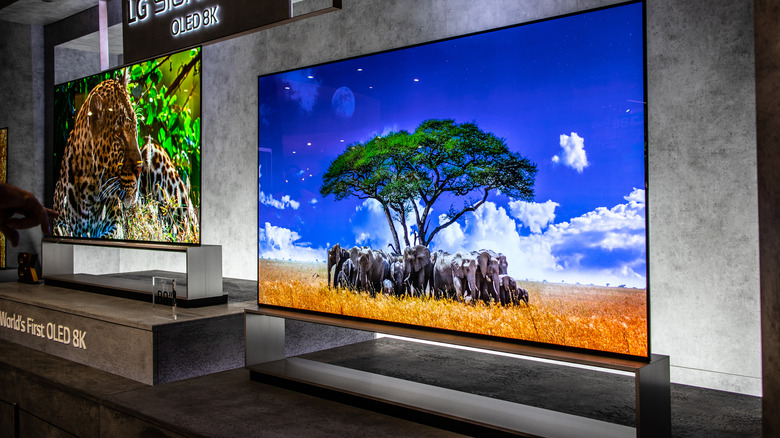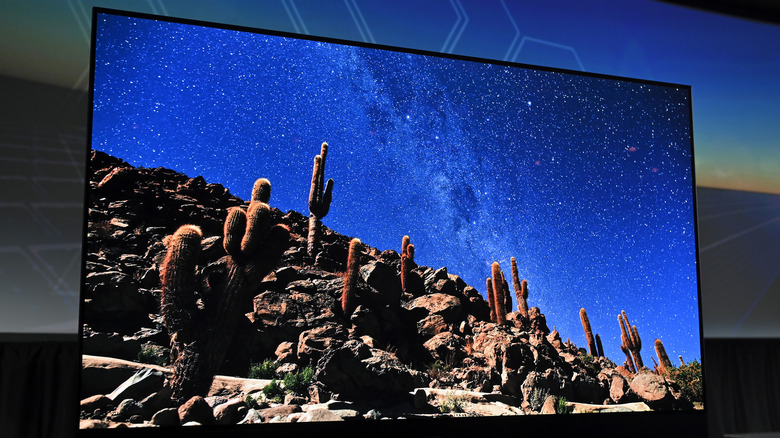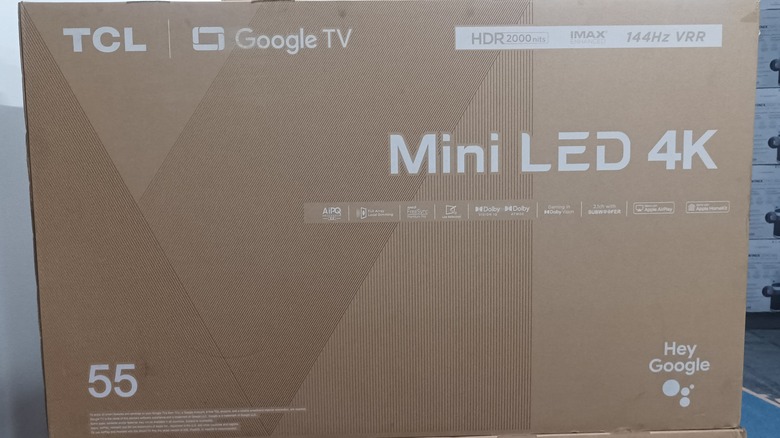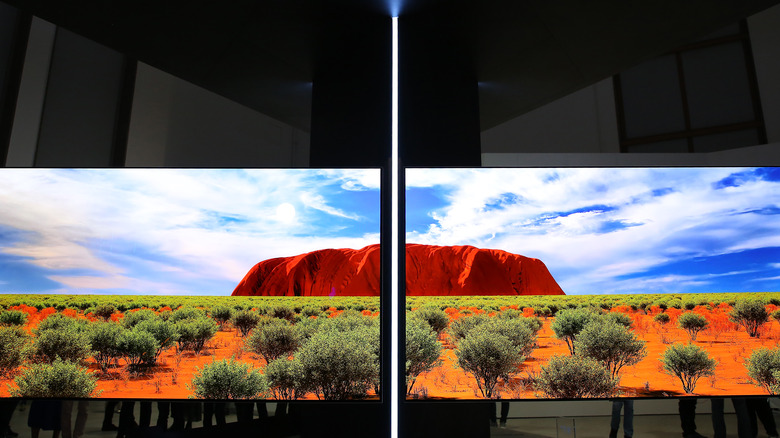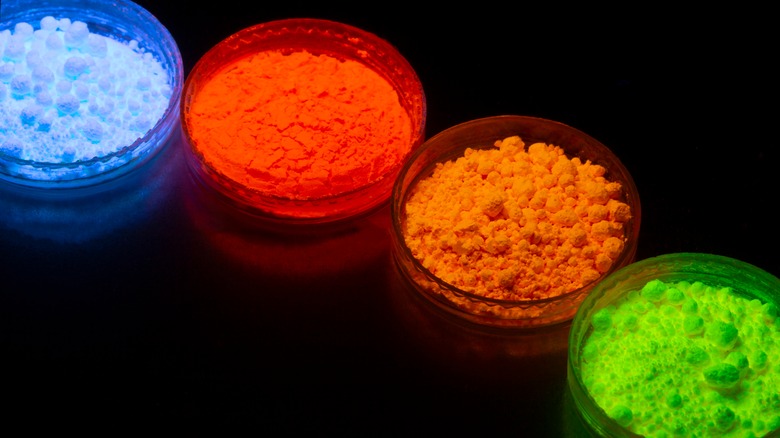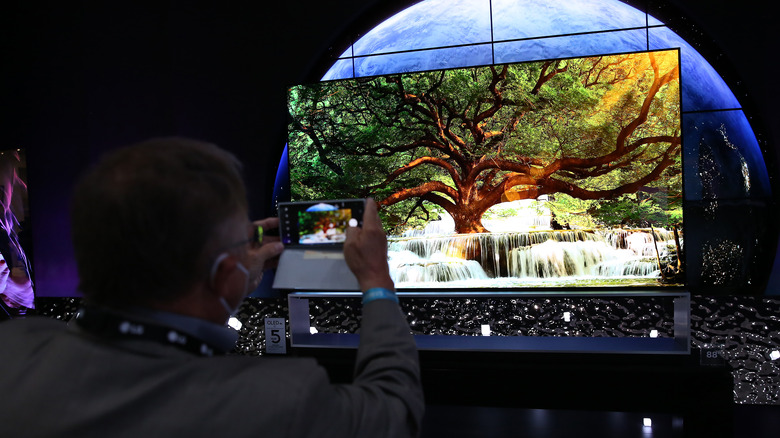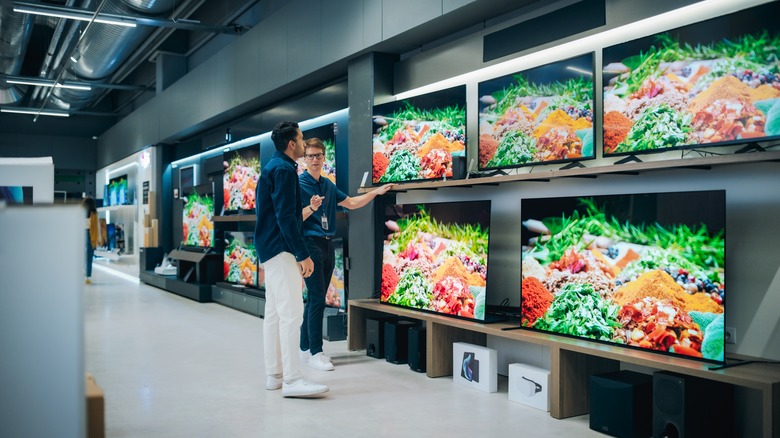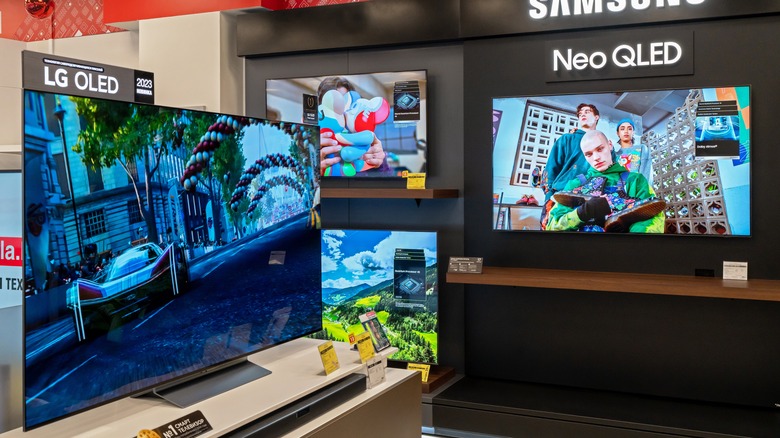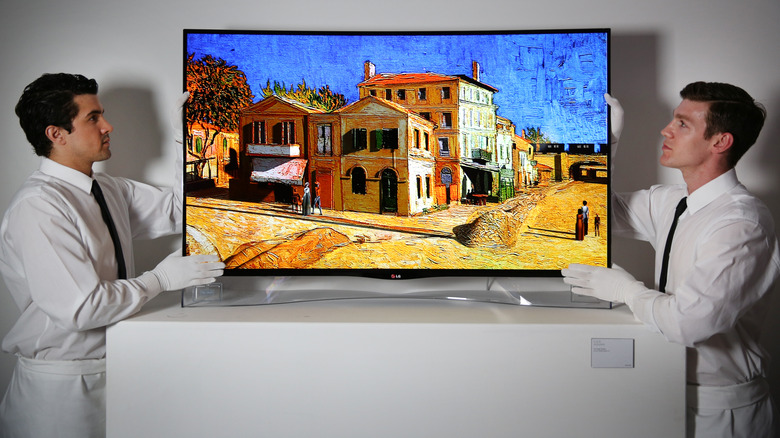Mini LED Vs. OLED TVs: Which TV Offers Better Image Quality?
If you're in the market for a new TV, you've probably noticed how many different kinds there are. High end TVs tend to come with OLED or LED technology powering the display, and near the high end of the LED market sits Mini-LED. You might be between OLED and Mini-LED. Would you even notice a difference, or could your choice lead to an inferior viewing experience? We'll unpack these two trendy TV technologies to figure out which one has the best image quality.
Your TV's display consists of a bunch of tiny lights called pixels that change color. Those tiny dots of color make a full picture. What differentiates OLED and Mini-LED is the way they illuminate pixels. While OLED pixels are self-illuminating and each can be operated individually, Mini-LED pixels have backlights aligned in up to thousands of different lighting zones that operate them in batches. Though it may seem inconsequential, the implications of this distinction are massive when it comes to what you see.
So, which of these display technologies belongs in your living room? We'll compare how they stack up in categories ranging from contrast and color to brightness. A television is a big investment, so of course we'll also see how they compare in price. Let's dive in to examine each display technology in more depth, so you can confidently choose what's right for you.
What is OLED?
OLED, which stands for Organic Light Emitting Diode, has been the envy of display nerds thanks to its unique, per-pixel abilities. Essentially each individual pixel of an OLED display is made up of an organic polymer material that converts electricity into light and can be powered individually. This contrasts with technologies like LED in which an entire array of pixels is powered as a group. As we'll see later, the main innovation of Mini-LED is to make more of these groups, whereas OLED does not have those constraints. Thanks to this unique advantage, OLED displays do not need to turn on every pixel when the screen is on. Only those that are required to display the image are in use.
For this reason, OLED is known both for its power efficiency and fantastic contrast levels. That's because, on OLED panels, black pixels are simply not turned on in the first place. This allows an OLED panel to display "true" blacks with an infinite contrast ratio. Since those black pixels aren't turned on, they aren't drawing power, which increases the energy efficiency of an OLED display compared to LED displays. They are also more malleable, which allows them to be shaped into form factors like foldable smartphones and curved or rollable TVs.
What is Mini-LED?
To understand Mini-LED, it is necessary to understand regular LED panels. An LED display is made up of two sheets of polarizing material between which is a liquid crystal emulsion solution. Electricity passed through that solution, the crystals respond by aligning themselves to either block or transmit light. Each pixel in an LED display can emit red, green, and blue (RGB) light, which is mixed to create additional colors you see on screen. The light itself is generated by LED lamps that sit behind everything else and shine light through. Older versions of LED technology had one giant backlight, but newer ones tend to have a few dozen.
In a Mini-LED display, however, there are many thousands of LEDs that can be controlled with a much higher degree of specificity. This means Mini-LED is capable of much higher contrast — the difference between the lightest and darkest parts of an image. In other words, blacks will look blacker and whites will look brighter. This also makes HDR (high dynamic range) content look better, which is a big deal since HDR is becoming more widespread for movies and television shows. It also allows for a wider color gamut (the range of different colors a display can produce), which is good news for gamers and cinephiles. Notably, Mini-LED is not the same as Micro-LED, but that's beyond the scope of this article.
Mini-LED has been used in a bunch of high-end products, including the previous generation of the iPad Pro. But this year, the M4 iPad Pro was updated to a specialized kind of OLED panel. So, with all the benefits of Mini-LED, why would a company like Apple choose OLED instead? Let's dive into the benefits of OLED to find out.
OLED has better contrast but worse brightness than Mini-LED
Many display afficionados are bound to opt for OLED over Mini-LED because of its superior contrast. While Mini-LED is known for having excellent contrast levels compared to traditional LED displays, the per-pixel control afforded by OLED means a greater degree of control over fine details. When an OLED is showing a black screen, every pixel is turned off, which means it looks truly black without any light shining from behind. For this reason, it can be extremely difficult to determine whether an OLED TV is turned on when no content is being displayed since the display has every pixel turned off (and, to be clear, that's generally a good thing).
However, while OLED dominates true blacks, Mini-LED may be the superior option when it comes to brightness. Because OLED displays illuminate each individual pixel, they struggle to reach the brightness levels LED displays with dedicated backlights are capable of reaching. Mini-LED TVs can reach extremely high brightness levels ranging from 1,500 nits to 3,000 nits. If your TV will be in a room with lots of sunlight, Mini-LED can help ensure that your TV screen is visible during daylight hours. However, if you've got a dark home theater area, you'll probably prefer OLED for its better contrast and true black tones.
OLED produces slightly better color than Mini-LED
Color gamut and accuracy can make a big difference to your TV viewing experience. TVs with poor color reproduction can look lifeless and unappealing, while those with great color reproduction will feel immersive and lifelike. When it comes to color, neither Mini-LED nor OLED are slouches, but the best OLED panels edge out the best Mini-LED panels in most cases. However, Mini-LED panels are getting better as time passes, and most experts seem to agree that neither really has an advantage these days. OLED panels will always be preferable for their true blacks, as we've discussed, but Mini-LED can produce brighter colors.
The quality of Mini-LED relative to OLED colors depends largely on the quality of the backlights it uses. OLEDs have traditionally been better at color accuracy since each pixel emits its own light, but top-end Mini-LEDs can now match them for quality. However, you might have to pay more for a high quality Mini-LED that can actually compete with the average OLED in terms of color reproduction, whereas even entry-level OLEDs will often produce fantastic colors.
Viewing angles are better on OLED
Viewing angles are an important but often overlooked factor that should be a part of your TV purchasing decision. When a TV has poor viewing angles, the image will appear degraded to those watching from an angle. The more pronounced their angle relative to the screen, the worse the effect will be. Unless you're sure that everyone who watches the TV will be viewing it head-on, you should consider how it will look to those watching at an oblique angle from the peripheries of the room.
OLED is the clear winner when it comes to viewing angles, as LED screens of all kinds are notorious for their often-poor viewing angles compared to OLED. This is because LED display backlights are shining straight through the display, meaning anyone not watching from close to head-on is not seeing all of the light. Meanwhile, OLEDs emit light in all directions because the light sources are the pixels themselves, which means that you'll have a better view even if you're watching from an oblique angle.
Price favors Mini-LED
For many looking to upgrade their TV or add another one to the household, the decision will come down to price. After all, if the gap in price is large enough, a slight gap in picture quality starts to feel negligible. In general, OLED TVs are more expensive than Mini-LED because of their more elaborate and delicate manufacturing processes.
For a non-scientific comparison, we looked at Best Buy's selection of OLED TVs in the 55"-64" range and found they vary in price from $1,300 for a 55" LG Class B4 Series 4K OLED and all the way up to $2,800 for a 55" Sony Bravia XR A95L 4K OLED. When we examined Mini-LED options in the same size range, the difference was stark, beginning at $500 for a TCL QM7 Series 4K Mini-LED and topping out at $1,700 for a Sony Bravia 7 4K Mini-LED QLED model. In other words, the most expensive Mini-LED was only $400 pricier than the cheapest OLED.
Is OLED worth the extra money? It depends on your needs. That $500 Mini-LED model from TCL is still going to look pretty good for the majority of video content, especially if you're upgrading for the first time in a while, and the difference picture quality from there to the $2,800 Sony Bravia OLED is probably not as steep as the price delta.
QLED is different from OLED or Mini-LED
If you're shopping for TVs, you'll often see the term QLED thrown around alongside OLED and Mini-LED. However, QLED has nothing to do with OLED. It is simply another technology that can be added to LED displays, and you'll often find Mini-LED TVs that also have QLED technology. In simple terms, QLED is a way of improving the contrast and saturation of LED displays to bring them closer to the vivid realism of an OLED display.
QLED works by adding a layer of semiconductive nanocrystals known as quantum dots in between the backlight and display. Quantum dots can change size instantaneously, and due to quantum physics, the size of these dots corresponds with their color. At their smallest, quantum dots appear blue, and at their largest, red. As they conduct a video signal, they expand and shrink to create the desired colors, and this can improve saturation and brightness compared to a traditional LED or Mini-LED display. In combination with Mini-LED, some QLED TVs can begin to approach the natural contrast and saturation of OLED while still retaining the superior brightness of LED. They cannot beat OLED's infinite contrast levels, but they do help to close the gap.
The bottom line is that QLED is a technology that can be added to LED displays, but not to OLED displays. QLED Mini-LED TVs often look better than Mini-LED alone, but can still be much cheaper than OLED, making them an attractive middle ground for many people.
The bottom line: OLED is better overall, but Mini-LED is still appealing
At the end of the day, both OLED and Mini-LED are remarkably great display technologies, and you can't go wrong with either. Of course, you should research the TV you plan on buying to make sure it's well-reviewed, but in general either will give you a fantastic home theater experience.
You should opt for an OLED if you plan to use the TV in a dark environment, if you want a TV that has picture perfect contrast with true blacks, better HDR and gaming performance, or if you want better viewing angles. You should spring for a Mini-LED instead if you want a bigger TV for the same price and close to the same image quality as a smaller OLED, or if you want a brighter screen for brighter viewing environments.
Once you've decided between OLED and Mini-LED, you've still got some choices left to make. You'll want to choose which major TV brand ranks worst to best for your needs, whether you plan to buy a budget TV or a top-of-the-line model, and which screen size is best for your needs. Don't forget to read reviews, either. Just because a TV is OLED or Mini-LED doesn't guarantee quality.
